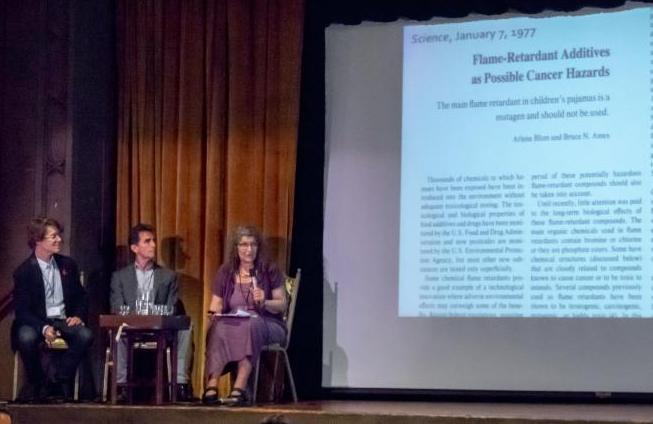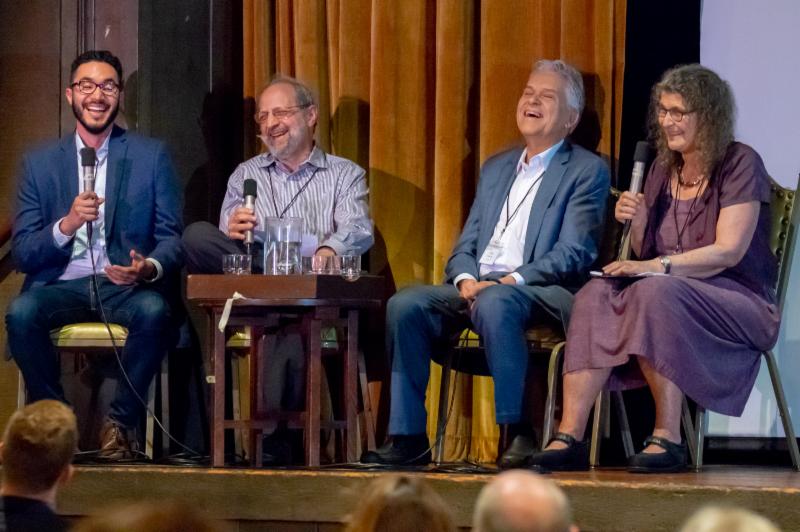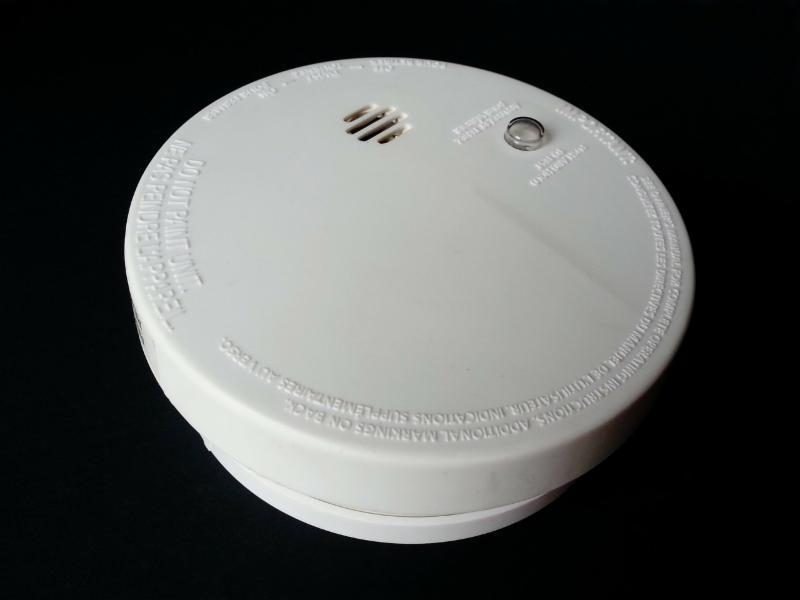October 2018 Newsletter – Celebration: A Decade of Big Ideas
Hello!

Russell Long, Mark Leno and Arlene reminisce about their early efforts to remove flame retardants from furniture.
I trust you are enjoying the beginning of fall. Last Sunday, we marked the 10-year anniversary of the Green Science Policy Institute with a wonderful Celebration of Big Ideas. Our friends and colleagues shared their inside stories of using big ideas based on science to achieve seemingly impossible goals for a healthier word. Many thanks to all of you who have shared our research, advocacy and adventures.
Our last decade has seemed like a roller coaster of ups and downs contributing to many successes such as toxic flame retardants no longer being needed in our nation’s furniture and baby products. And colleagues in California just passed legislation banning the sale of furniture, children’s products, and mattress foam that contain any flame retardant, overcoming industry opposition. In a memorable short video, John Oliver exposes the flame retardant industry front group Citizens for Fire Safety that was our nemesis. (See Astroturfing: Last Week Tonight.)
Can you believe we had some excellent news from the Hill in DC last week? On Wednesday the Senate passed bipartisan legislation 93 to 6 which will allow commercial airports in the U.S. to use firefighting foams without highly fluorinated chemicals or PFAS. (FAA rules currently require civilian airports to use harmful PFAS-containing foams while airports outside the U.S. areincreasingly using safer alternatives.) This FAA legislation will help prevent drinking water contamination from PFAS in communities near airports.
House staff first learned about the need for a change in FAA policy to allow foams without PFAS during our March 2018 monthly PFAS Hill webinar. Over the summer, we met with dozens of Senate and House offices to educate them about this harmful chemical class. This press release explains more about the new legislation –another Big Idea!

JR Delarosa, Michael Lipsett, Vyto Babrauskas & Arlene celebrate removing flame retardants from furniture.
I am so grateful for our opportunities to reduce the use of harmful chemicals over the last ten years.
I especially want to thank our current and past staff , consultants, and volunteers who have worked diligently day after day (and sometimes night!) to advance our goal of a healthier world for all.Have a good autumn,Arlene and the Green Science Policy team
P.S. Please remember to register to vote and encourage others to do so. Participation is more critical than ever for our democracy to flourish.
From Beagles to the Bay-Pet Pesticide Pollution
by Alexa Reynoso

Chemicals in flea treatments are harming ecosystems.
We want our pets to be healthy, but could something that keeps them well be harming ecosystems? Many flea treatments such as Frontline and PetArmor contain pesticides called Fipronil or Imidacloprid that may be harming the food web in the San Francisco Bay, according to scientists at the San Francisco Estuary Institute (SFEI).
The pesticides get on our hands and laundry, and when we wash them (or our pets), they head down the drain to wastewater treatment plants, and eventually end up in sediments at the bottom of the bay. According to Rebecca Sutton of SFEI, “that’s the base of our food web. So, if those critters experience impacts, it could go up and harm our fish and our wildlife.”
A recent study found Fipronil in all tested sewage treatment plants at concentrations above the U.S. EPA’s recommended limit. Imidacloprid was also found at levels between 84 and 305 parts per trillion, well above the limit of 10 parts per trillion.
How can you protect both your pet and the environment? One way to reduce the risk of fleas is to vacuum your home and your pet’s bedding often, comb your pet’s fur with a fine-tooth flea comb, and drown any fleas you find in a cup of water. If your pet still needs flea treatment, safer alternatives to Fipronil and Imidacloprid are available – see these tips for pet owners and veterinarians from Bay Area water agencies.
A Good Reason to Turn off Electronics: Flame Retardant Exposure
by Barbara Kyle

Computers in use emit harmful flame retardants
Flame retardants added to plastic enclosures around electronics are not chemically bound to the plastics, and can migrate out into the environment. Many studies have measured flame retardants in the dust and air near electronics. But it’s been hard to know how much of the flame retardants in the samples were emitted from electronics versus the furniture, carpet, etc. Until now.
A recent study evaluated air and dust samples in four rooms of a newly constructed building in the Czech Republic. To measure the relative off-gassing flame of retardants from building materials, furniture, carpeting and electronics, samples were collected at key intervals during construction and furnishing of the rooms.
No significant increase in flame retardant levels in the air was found when furniture and computers were installed in the rooms. However after the computers were turned on, concentrations of halogenated flame retardants in the room dust increased by 886%. The study’s authors cautioned that these levels could be of concern in terms of long-term human exposure for people who work most of the day in offices or computer rooms.
Are There Batteries in Your Smoke Detector?

Photoelectric smoke alarms are more effective
Have you ever removed the batteries from your smoke detector because it annoyingly went off while you were cooking or showering, or for no apparent reason at all?
Good, functioning alarm systems will protect us from fires in our homes; they are a more effective and healthier option than adding flame retardants to furniture.
Photoelectric smoke alarms are a better alternative than the more commonly-used ionization smoke alarms – they can detect smoldering fires smoke and do not give so many false alarms.
Photoelectric alarms are now required in Massachusetts, and data shows that they have lead to a decrease in fire deaths. You should periodically check your smoke alarms to verify that they are functioning. If you have disabled your smoke alarms because of frequent false alarms, you might want to consider installing a photoelectric alarm.
Banning the BPA Alphabet Soup
by Alexa Reynoso
 The state of New York recently introduced a bill that would expand the “Bisphenol A-free Children and Babies Act” of 2010 to cover several common BPA substitutes. Current law prohibits the sale of any children’s products containing BPA, but does not prohibit substitution of related chemicals that have similar structure and can cause similar health harm.
The state of New York recently introduced a bill that would expand the “Bisphenol A-free Children and Babies Act” of 2010 to cover several common BPA substitutes. Current law prohibits the sale of any children’s products containing BPA, but does not prohibit substitution of related chemicals that have similar structure and can cause similar health harm.
Bisphenols are found in products from cash register receipts to metal can linings to water bottles, and as a result they are also found in most of us. Bisphenol exposure has been associated with reproductive disorders, cancer, neurodevelopmental problems and asthma.
The new legislation, scheduled to go into effect on December 31, 2019, was initiated after a recent study showed the estrogenic effects of six different bisphenols. The state amendment will expand the existing ban to now include: bisphenols AF, Z, S, F, AP, and B.
Calendar
The UCSF Program on Reproductive Health and the Environment is hosting a screening of the new documentary ‘The Devil We Know’, about the story of PFOA contamination around the Parkersburg, West Virginia DuPont plant. Tom Bruton will be participating on a Q&A panel afterwards. Admission is free. More information is here.
November 4-8, 2018: Society of Environmental Toxicology and Chemistry (SETAC) North America 39th Annual Meeting, Sacramento, California
Tom Bruton will speak about firefighting foam and PFAS on Tuesday, November 10. Arlene Blum will talk about emerging flame retardants at 11:00AM and the Six Classes and scientific communication at 1:20PM on Wednesday.
February 15, 2019: Green Science Policy Symposium: Flame Retardant Dilemma and Beyond